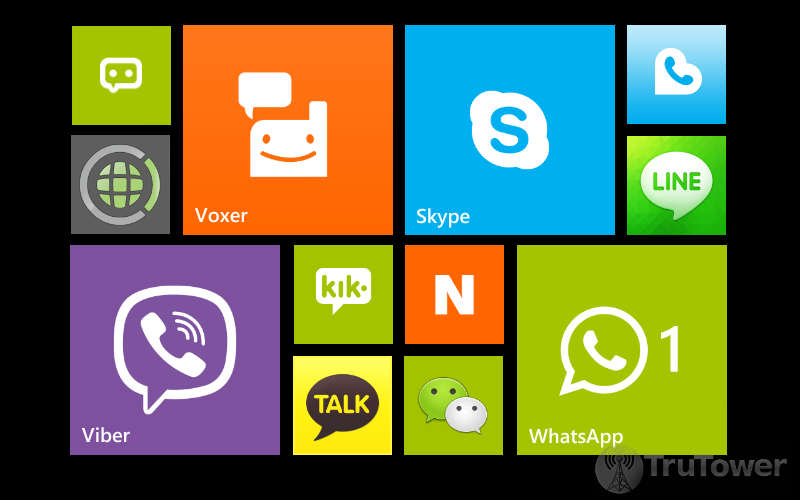There are a lot of messaging and calling applications, most of which we cover right here on TruTower. It’s a fragmented space, a road to travel with seemingly endless offramps that ultimately lead to the same goal: connecting people. This has lead to confusion for some users and an annoyance to others, who have to regularly use multiple applications in order to stay in touch with their entire social circle.
Nimbuzz CEO Vikas Saxena once said that up to “five instant messaging apps” would be used by customers on their mobile devices to keep in touch with contacts. Seeing the growth of the various platforms the past year and the tens of millions of users each one has hooked, it seems more apparent that this number is a little closer to ten; these ten apps will be the queens of the messaging anthill in the future.
Up to five messaging apps will be used by consumers on mobile devices to keep in touch with contacts.
The biggest platforms by user count — Skype, Viber, LINE, Kik Messenger, KakaoTalk, Tango, Nimbuzz, ooVoo, WeChat, and WhatsApp — are likely to continue on their own for the time being (with the exception of Skype, which is of course owned by Microsoft) and a case can be made that many are too big for acquisition except by larger corporations.
Fring was already acquired by Genband, a much larger company, back in September and since then the company has been repositioning Fring to make it more competitive with other apps on the market. Needless to say, it’s unlikely that Fring will be seeking a new home anytime soon.
Twitter has already stuck its beak into Vine, so that’s another application that’s off the chopping block.
However, there are still many apps that are ripe for picking. Snapchat, for example, which currently includes 40 million users. Snapchat was the recent target of a $3 billion acquisition by Facebook. The offer was turned down, but it wasn’t due to the company being uninterested in selling. Snapchat CEO Evan Spiegel was reportedly not interested in an acquisition at this time simply because he wanted to increase the app user base and overall value and would “not likely consider an acquisition or an investment at least until early next year” according to the reports. At that time, it’s perfectly possible that Snapchat could be open to acquisition.
Merging is another alternative to acquisition for messaging platforms.
Merging is another possibility for apps. Imagine being able to use Viber to chat with both Viber and Snapchat contacts, which would number in the hundreds of millions. Your Viber video messages and picture messages could be set to automatically expire after viewing and you would have the ability to send sticker-laden picture messages to your Snapchat contacts (who doesn’t love Violet?) This is, of course, just a speculative scenario on the feature side. On the team side, development for all of the major mobile platforms would be likely improved and updates will become more commonplace as teams are able to grow larger.
In addition to gaining users and features, apps could even become part of an entire ecosystem a la Skype or Google Voice. As the apps, the ecosystems, and the companies who offer them get bigger, so does the competition.
More profitable monetization is a benefit for app developers. If Tango, for instance, acquired another application and its users, it would give the company a much larger user base for which to leverage its gaming platform as well as advertising instantly. With localization improvements also a possibility as a result of merging, this would allow apps to expand to additional countries much more quickly, which would benefit the platforms, their consumers, and their developers as the customer base can further expand and the competition continues to increase.
Competition will make things increasingly difficult for smaller apps, leaving a limited number of strong players in the field.
While that competition will make things increasingly more difficult for smaller messaging apps and leave only a limited number of strong players in the field — using the ten-app-per-user scenario mentioned at the beginning of this piece as an example — ten healthy and competitive messaging platforms can actually make things better for the consumer, beyond the addition of more users to call and message for free and more features to use.
So while it’s not clear how exactly these merges or acquisitions unfold in the future, The TruTh is, it’s still highly likely that they’ll occur and will lead us to new roads. Could the future of gaming be embedded in a messaging platform rather than a company like Nintendo? Could VoIP and messaging apps be integrated into our televisions, giving users instant access to messages, contacts, phone calls, and news much like operating systems and additional apps do now? Or perhaps messaging and calling apps will give way to some unknown new innovations down the road, innovations that could lead to other offramps that test the very boundaries of imagination? Such endless vistas of possibility.

